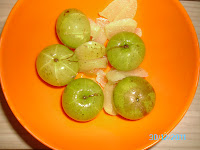Amla, better known as Indian Gooseberry, is widely used in the Ayurvedic medicine (a traditional medicine system in India) system of India. Amla is extremely rich in vitamin C, having thirty percent more than oranges. It’s packed with many vitamins, minerals, tannins and other helpful nutrients. Amla also works well for inflammation. It is a good anti-inflammatory for joints especially. This potent herb is also used to reduce fevers, strengthen the heart, control blood sugar, treat urinary tract infections and improve eyesight. (reference from http://www.herbslist.net/amla.
On the way to Vulture Peak, Thay bought some amla fruits for us because we all had sore throat. Thay told us Indians use this fruit as a herbal medicine to cure sore throat. The taste of amla is incredible. The taste of amla fruit is sour, bitter, sharp, astringent, and it is quite fibrous but the after taste is incredibly sweet. The sweet sensation lingered in my throat and between my teeth, it was amazing. I was dumbfounded by how the fruit soothed my throat.
In my opinion, a person who embodies the sentiments of an amla is one who faces their hardships with persistence and courage. Despite of meeting many adversities in one’s life, one will eventually taste the sweetness of success. I believe the meaning of this fruit correlates to the life of the Buddha. Siddhartha gave up his luxurious life and lived as an ascetic for six years. During those six years he practiced with all his might, seeking the answer to end suffering. Through endless meditation he reached Buddhahood and discovered the ‘Middle Path’ .
There are many Chinese idioms for this fruit:
31/12/2011
On the way to Vulture Peak, Thay bought some amla fruits for us because we all had sore throat. Thay told us Indians use this fruit as a herbal medicine to cure sore throat. The taste of amla is incredible. The taste of amla fruit is sour, bitter, sharp, astringent, and it is quite fibrous but the after taste is incredibly sweet. The sweet sensation lingered in my throat and between my teeth, it was amazing. I was dumbfounded by how the fruit soothed my throat.
In my opinion, a person who embodies the sentiments of an amla is one who faces their hardships with persistence and courage. Despite of meeting many adversities in one’s life, one will eventually taste the sweetness of success. I believe the meaning of this fruit correlates to the life of the Buddha. Siddhartha gave up his luxurious life and lived as an ascetic for six years. During those six years he practiced with all his might, seeking the answer to end suffering. Through endless meditation he reached Buddhahood and discovered the ‘Middle Path’ .
There are many Chinese idioms for this fruit:
- Light at the end of the tunnel
- Bitterness finishes, sweetness begins (苦盡甘來)
- Pleasure comes through toil
31/12/2011


No comments:
Post a Comment